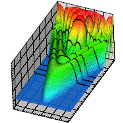Department of Physics and Astronomy: Publications and Other Research

Anthony F. Starace Publications
Document Type
Article
Date of this Version
11-2013
Citation
J. Phys. B: At. Mol. Opt. Phys. 46 (2013) 231001 (7pp)
doi:10.1088/0953-4075/46/23/23
Abstract
The interpretation of many high-order harmonic generation (HHG) experiments is based on the assumption that the HHG yield of an atom can be factorized into (i) a laser-dependent ‘electron wave packet’ with rather simple properties, including a nearly universal shape, and (ii) an atomic photorecombination cross section. We show that this factorization is restricted to linearly polarized laser fields and fails in two-colour laser fields with orthogonal polarizations. At the same time, we show how two-colour HHG spectroscopy using orthogonally polarized intense fundamental and relatively weak second harmonic fields makes a complete experiment possible that enables the retrieval of the angle-resolved photorecombination cross sections for atomic p states.
Included in
Atomic, Molecular and Optical Physics Commons, Elementary Particles and Fields and String Theory Commons, Plasma and Beam Physics Commons


Comments
Copyright 2013 IOP Publishing Ltd. Used by permission.